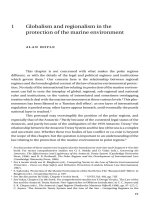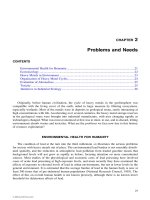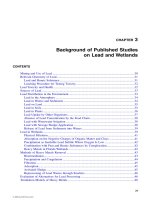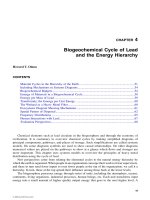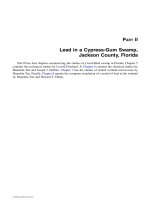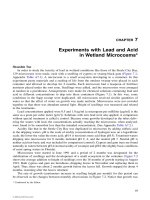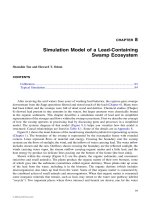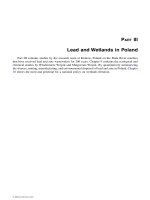Measurement and behaviour of heavy metals in the marine environment of singapore
Bạn đang xem bản rút gọn của tài liệu. Xem và tải ngay bản đầy đủ của tài liệu tại đây (2.81 MB, 174 trang )
MEASUREMENT AND BEHAVIOR OF HEAVY METALS
IN THE MARINE ENVIRONMENT OF SINGAPORE
DANG THE CUONG
NATIONAL UNIVERSITY OF SINGAPORE
2005
MEASUREMENT AND BEHAVIOR OF HEAVY METALS
IN THE MARINE ENVIRONMENT OF SINGAPORE
DANG THE CUONG
(B.Eng. (Hons.), Ho Chi Minh City University of Technology, Vietnam)
A THESIS SUBMITTED
FOR THE DEGREE OF MASTER OF ENGINEERING
DEPARTMENT OF CHEMICAL & BIOMOLECULAR
ENGINEERING
NATIONAL UNIVERSITY OF SINGAPORE
2005
ACKNOWLEDGEMENTS
This dissertation could not have been written without Associate Professor Jeffrey
Philip Obbard who not only served as my supervisor but also encouraged and challenged
me throughout my academic program. He patiently guided me through the dissertation
process, never accepting less than my best efforts. I wish to express my sincerest
appreciation and thanks to him for his guidance and encouragement during my
dissertation work.
I gratefully acknowledge the support of the National University of Singapore
through the award of the Research Scholarship.
I sincerely wish to thank the Tropical Marine Science Institute for facilities in the
sampling of the sediment and seawater samples and for facilities in measurement
techniques.
I also would like to express my gratitude to the National Parks of Singapore for
granting access to the nature reserves, for the help provided for my study, particularly
from the staff from Sungei Buloh Nature Reserve, Singapore.
I am very thankful to all the staff of the Tropical Marine Science Institute and the
Department of Chemical and Biomolecular Engineering, National University of
Singapore for facilitating the administrative aspects of my research.
i
My best regards I would like to give to the laboratory officers Mdm Li Fengmei,
Susan Chia, Li Xiang and the professional officer Mr. Qin Zhen for their technical and
laboratory assistance in this project.
I gratefully thank the crew of the Hammerhead, especially Oliver Wurl and Dr.
Subramanian Karuppiah for their skilled assistance in both field and laboratory work.
My special thanks to all my research group members Dr. Xu Ran, Li Qing Qing,
Lau Ning Ling Angelina, Lim Yong Giak, Lee Minli, Tan Yen Ling, Tan Jing, Lim Tian
Fu, Le Thi Phuong Thao, Oliver Wurl, Dr. Stéphane Bayen, Dr. Subramanian Karuppiah,
Wesley Hunter, Arun Marimuthu, Dr. Wu Shuiping. I would like to say that it was a
pleasure to work with you. I want to thank you all for all your kindly help, support,
interest and valuable hints.
I would like to take this opportunity to express my sincere appreciation and
special thanks to all of my friends for their valuable support and encouragement.
Finally, I feel a deep sense of gratitude for my parent who formed part of my
vision, taught me the good things that really matter in life and made me what I am today.
Also, I am very grateful for the love, spiritual support and encouragement of my sisters,
my brothers throughout my study.
ii
TABLE OF CONTENTS
ACKNOWLEDGEMENT................................................................................................. i
TABLE OF CONTENTS ................................................................................................ iii
SUMMARY ...................................................................................................................... ix
NOMENCLATURE......................................................................................................... xi
LIST OF FIGURES ........................................................................................................ xii
LIST OF TABLES ......................................................................................................... xiv
CHAPTERS
1. INTRODUCTION..........................................................................................................1
1.1 Background ............................................................................................................1
1.2 Objectives and scope..............................................................................................3
1.2.1 Heavy metals in the seawater column and sediments in the coastal
environment of Singapore ......................................................................................3
1.2.2 Metal speciation in coastal marine sediments from Singapore using a
modified BCR-Sequential extraction procedure....................................................3
1.2.3 Heavy metal contamination in mangrove habitats of Singapore.................4
2. LITERATURE REVIEW .............................................................................................5
2.1 Introduction to heavy metals ................................................................................5
2.1.1 History of heavy metal use.............................................................................5
2.1.2 What are heavy metals? .................................................................................5
2.1.3 Sources of heavy metals.................................................................................6
2.1.4 Sources of heavy metal contamination .........................................................7
2.1.5 The effects of heavy metals to human beings ...............................................8
iii
2.2 Heavy metals in the sea-surface microlayer (SML)..........................................10
2.2.1 Definition of the sea-surface microlayer (SML).........................................10
2.2.2 Sampler and sampling techniques...............................................................11
2.2.3 The enrichment of heavy metals in the SML ..............................................14
2.3 Heavy metals in the water column .....................................................................16
2.3.1 Sources of heavy metals in the water column.............................................16
2.3.2 Metal partitioning – dissolved and particulate phases ...............................17
2.3.3 Distribution and behavior of heavy metals in the water column ...............18
2.4 Chemical speciation of heavy metals in marine sediments ..............................22
3. MATERIALS AND METHODS ................................................................................29
3.1 Chemicals..............................................................................................................29
3.2 Cleaning method for lab-ware ............................................................................29
3.3 Sample preparation .............................................................................................30
3.3.1 Seawater .......................................................................................................30
3.3.1.1 Sample preparation for dissolved metals.............................................30
3.3.1.2 Sample preparation for particulate metals ..........................................31
3.3.2 Biota..............................................................................................................31
3.3.2.1 Homogenization ...................................................................................31
3.3.2.2 Microwave assisted extraction.............................................................32
3.3.3 Marine sediment...........................................................................................32
3.3.3.1 Preparation for sediment samples .......................................................32
3.3.3.2 Determination of moisture content in air-dried sediments ..................33
3.3.3.3 Microwave-assisted acid digestion procedure.....................................33
3.3.3.4 Modified BRC sequential extraction procedure ..................................34
iv
3.4 Graphite furnace atomic absorption spectrometry (GFAAS) .........................36
3.5 Inductively coupled plasma–mass spectroscopy (ICP-MS) .............................38
3.6 Analytical quality control....................................................................................40
3.6.1 Procedural blank..........................................................................................40
3.6.2 Replication....................................................................................................40
3.6.3 Certified reference materials (CRMs)/Standard reference materials
(SRMs)...................................................................................................................40
4. HEAVY METALS IN THE SEAWATER COLUMN AND SEDIMENTS IN THE
COASTAL ENVIRONMENT OF SINGAPORE .........................................................42
4.1 Introduction..........................................................................................................42
4.2 Materials and methods ........................................................................................44
4.2.1. Study area....................................................................................................44
4.2.2 Sample collection .........................................................................................46
4.2.3 Sample preparation ......................................................................................48
4.2.4 Sample analysis ............................................................................................49
4.3 Results and discussion .........................................................................................50
4.3.1 Quality assurance.........................................................................................50
4.3.2 In-situ analysis .............................................................................................52
4.3.3 Concentrations of heavy metals in the water column and sediments ........53
4.3.3.1 Dissolved heavy metals in the water column .......................................53
4.3.3.2 Particulate heavy metals in the water column.....................................56
4.3.3.3 Heavy metals in sediments ...................................................................59
4.3.4 Vertical distribution of heavy metals in the water column.........................61
4.4 Conclusions...........................................................................................................66
v
5. METAL SPECIATION IN COASTAL MARINE SEDIMENTS FROM
SINGAPORE USING A MODIFIED BCR-SEQUENTIAL EXTRACTION
PROCEDURE ..................................................................................................................68
5.1 Introduction..........................................................................................................68
5.2 Materials and methods ........................................................................................70
5.2.1 Study area.....................................................................................................70
5.2.2. Sample collection and preparation.............................................................71
5.2.3 Apparatus .....................................................................................................72
5.2.4 Modified BCR sequential extraction method..............................................73
5.3 Results and discussion .........................................................................................74
5.3.1 Quality assurance.........................................................................................74
5.3.2 Total metal content.......................................................................................78
5.3.3 Metal speciation ...........................................................................................80
5.4 Conclusions...........................................................................................................84
6. HEAVY METAL CONTAMINATION IN MANGROVE HABITATS OF
SINGAPORE....................................................................................................................86
6.1 Introduction..........................................................................................................86
6.2 Methods.................................................................................................................87
6.2.1 Study area.....................................................................................................87
6.2.2 Sample collection and preparation..............................................................89
6.2.3 Heavy metal analysis....................................................................................90
6.2.3.1 SML and subsurface seawater samples ...............................................90
6.2.3.2 Sediment samples .................................................................................91
6.2.3.3 Biota samples .......................................................................................91
6.3 Results ...................................................................................................................92
6.3.1 Quality assurance.........................................................................................92
vi
6.3.2 Heavy metals in subsurface and SML seawater samples ...........................93
6.3.3 Heavy metals in mangrove sediments .........................................................95
6.3.4 Heavy metals in mangrove fauna................................................................95
6.4 Discussion..............................................................................................................95
6.4.1 Heavy metals in subsurface water ...............................................................95
6.4.2 Heavy metals in the SML.............................................................................96
6.4.3 Heavy metals in sediments...........................................................................98
6.4.4 Heavy metals in biota...................................................................................99
6.4.5 Comparison with international data ...........................................................99
6.5 Conclusions.........................................................................................................101
7. CONCLUSIONS AND RECOMMENDATIONS...................................................102
7.1 Summary of main conclusions ..........................................................................102
7.1.1 Heavy metals in the seawater column and sediments in the coastal
environment of Singapore (Chapter 4) ..............................................................102
7.1.2 Metal speciation in coastal marine sediments from Singapore using a
modified BCR-sequential extraction procedure (Chapter 5).............................104
7.1.3 Heavy metal contamination in mangrove habitats of Singapore (Chapter
6) ..........................................................................................................................105
7.2 Recommendations ..............................................................................................106
REFERENCES...............................................................................................................108
APPENDICES
APPENDIX A: HEAVY METALS IN THE SEAWATER COLUMN AND
SEDIMENTS IN THE COASTAL ENVIRONMENT OF SINGAPORE................126
A.1 DOC (mg/L), TOC (mg/g) and SPM (mg/L) in water column ..................................126
A.2 Concentrations of dissolved metals (µg/L) in the water column ..............................128
A.3 Concentrations of particulate metals (µg/g) in the water column............................131
vii
A.4 Concentration of particulate metals (µg/L) in the water column .............................134
A.5 Concentrations of heavy metals (µg/g) in marine sediments....................................137
A.6 Dissolved metal concentrations (µg/g) in the coastal waters from Singapore and
other locations .................................................................................................................138
A.7 Concentration of particulate metals (µg/g) in the coastal waters from Singapore and
other locations .................................................................................................................141
A.8 Concentrations and enrichment factors (EF) of heavy metals in the sea-surface
microlayer water from Singapore and other locations....................................................142
A.9 Concentration of heavy metals in sediments (µg/g) from Singapore and other
locations...........................................................................................................................145
APPENDIX B: METAL SPECIATION IN COASTAL MARINE SEDIMENTS
FROM SINGAPORE USING A MODIFIED BCR-SEQUENTIAL EXTRACTION
PROCEDURE ................................................................................................................147
B.1 Concentrations of heavy metals (µg/g) in marine sediments of Singapore relative to
other countries .................................................................................................................147
B.2 Heavy metal concentrations in sediment samples (µg/g) at Kranji and Pulau Tekong
using the modified BCR-sequential extraction procedure ...............................................148
APPENDIX C: HEAVY METAL CONTAMINATION IN MANGROVE
HABITATS OF SINGAPORE......................................................................................153
C.1 Concentrations of heavy metals (µg/L) in mangrove and coastal subsurface waters of
Singapore .........................................................................................................................153
C.2 Concentrations of heavy metals (µg/L) in the SML of Singapore .............................154
C.3 Concentrations of heavy metals (µg/g dry weight) in mangrove and coastal sediments
of Singapore relative to other countries ..........................................................................155
C.4 Concentrations of heavy metals in mangrove biota of Singapore relative to other
countries. Levels are presented as µg/g wet weight, except where stated otherwise.......157
viii
SUMMARY
The distribution and behavior of heavy metals in the marine environment, as well
as their impact upon marine organisms and human health, are of great concern due to
their persistent, non-biodegradable and toxic properties. To date, there have been a few
studies on heavy metal pollution in the marine environment of Singapore and data on the
vertical distribution of heavy metals in the seawater column are lacking. In addition, there
have been no investigations on the chemical speciation of heavy metals in local marine
sediments, levels of heavy metals in coastal mangrove habitats. The main objectives of
this research were (i) to evaluate the prevailing heavy metal levels in the seawater column
and marine sediments, as well as the vertical distribution of heavy metals in the seawater
column in the coastal environment of Singapore; (ii) to determine the chemical speciation
of heavy metals in the marine sediments in order to understand their relative mobility and
bioavailability in the marine environment; and (iii) to determine prevailing levels of
heavy metals in representative mangrove habitats of Singapore.
Concentrations of heavy metals were determined in the water column (including
the sea-surface microlayer (SML), subsurface, mid-depth and bottom water) and
sediments at two sampling sites (Kranji and Pulau Tekong) with contrasting
hydrodynamic characteristics. Overall, heavy metals in both the dissolved and particulate
fractions have depth profiles that show a decreasing trend of concentration from the
subsurface to bottom water, indicating that the prevalence of metals is linked to the
marine biological cycle. In comparison to data from Greece, Malaysia, USA, the
ix
Netherlands and the Northern Adriatic Sea, the levels of metals in the dissolved phase
(DP) and suspended particulate matter (SPM) are considered to be low in Singapore. The
marine sediments in Singapore are not heavily contaminated when compared to metal
levels in marine sediments from other countries including Thailand, Japan, Korea, Spain
and China.
Further study on the chemical speciation of heavy metals in marine sediments
from Kranji in the northwest, and Pulau Tekong in the northeast of Singapore was
determined using a modified BCR-sequential extraction procedure. Results indicated that
all metals, except Cd, were more mobile and bio-available in Kranji, where metals were
present at higher percentages in the acid-soluble fractions (the most labile fraction).
Overall, with regard to Cr and Pb, both sampling sites have a similar distribution pattern
while Cd, Cu, Ni, and Zn have contrasting distributions in the sediments from both sites.
Concentrations of heavy metals in the SML and subsurface water, sediments and
biota were measured in two mangrove habitats in Singapore located in the West (Sungei
Buloh) and the East Johore Strait (Sungei Khatib Bongsu). Comparison of heavy metal
concentrations in seawater, sediments and biota from the two sampling sites indicate that
prevailing metal levels in the West Johore Strait are lower than in the East Johore Strait.
Overall, with respect to heavy metal contamination, mangrove habitats in Singapore are
less contaminated than those found in Deep Bay, Hong Kong and in Brazil, but more
contaminated than those in Australia and Mexico.
x
NOMENCLATURE
BC
Before Christ
BCR
The Community Bureau of Reference (now Standards, Measurements and
Testing Programme)
CRM
Certified Reference Material
DOC
Dissolved Organic Carbon
DP
Dissolved Phase
EFs
Enrichment Factors
EPA
US Environmental Protection Agency
GESAMP
The Joint Group of Experts on the Scientific Aspects of Marine
Environmental Protection
GFAAS
Graphite Furnace Atomic Absorption Spectrometry
ICP-MS
Inductively Coupled Plasma – Mass Spectrometry
Nd.
Not detected
NIST
National Institute for Standards and Technology
NRCC
National Research Council of Canada
RPM
Rotations per Minute
SB
Sungei Buloh
SKB
Sungei Khatib Bongsu
SML
Sea-surface Microlayer
SPM
Suspended Particulate Matter
SRM
Standard Reference Material
TOC
Total Organic Carbon
xi
LIST OF FIGURES
Figure 2.1
Sources and sinks of natural and man-made materials and the seasurface microlayer (Liss, 1975)
11
Figure 2.2
Rotating drum sampler (Harvey, 1966)
12
Figure 2.3
Schematic diagram of the rotating drum sampler (Harvey, 1966)
12
Figure 2.4
Glass plate sampler (Harvey and Burzell, 1972)
13
Figure 2.5
Transport processes for particulate matter in the microlayer
(Hunter, 1980)
14
Figure 2.6
The fate of dissolved trace metals at the SML (Lion and Leckie,
1981; Hardy, 1982)
15
Figure 2.7
Movement of pollutants in the hydrosphere (Fergusson, 1990)
16
Figure 2.8
Metal partitioning in water column among 3 major phases (inside
triangle) and some environmental conditions that favor each phase
(outside triangle) (Elder, 1988)
18
Figure 3.1
The ELGA water purifier
29
Figure 3.2
The MARSX (CEM) microwave oven
33
Figure 3.3
The Perkin-Elmer AAnalyst 600 Spectrometer
36
Figure 3.4
Graphite tube
36
Figure 3.5
The ELAN 6100 ICP-MS (Perkin-Elmer, Wellesley, MA)
38
Figure 3.6
Series of processes a drop of sample undergoes in the ICP-MS
(Barshick et al., 2000)
39
Figure 4.1
Singapore map (Source: WorldSwitch.com)
44
Figure 4.2
Location of Kranji and Tekong in Singapore
46
Figure 4.3
The SML rotating drum sampler
47
Figure 4.4
Analyzing heavy metals in the samples using the GFAAS
50
xii
DOC (mg/L), TOC (mg/g) and SPM (mg/L) profiles in the water
Figure 4.5
(a, b, c, d, e, column from two coastal regions of Singapore (Station 1 – Kranji
and Station 2 – Pulau Tekong)
f)
53
Dissolved metal profiles in the water column from two coastal
Figure 4.6
(a, b, c, d, e, regions of Singapore (Station 1 – Kranji and Station 2 – Pulau
f, g, h, i, j, Tekong)
k, l, m, n)
62
Particulate metal profiles in the water column from two coastal
Figure 4.7
(a, b, c, d, e, regions of Singapore (Station 1 – Kranji and Station 2 – Pulau
f, g, h, i, j, Tekong)
k, l)
64
Figure 5.1
The Balmar mechanical shaker
72
Figure 5.2
The Techne TE-8D Water Bath
72
Figure 5.3
The Kubota 5100 centrifuge
72
Figure 5.4
Diagram of the modified BCR sequential extraction procedure
73
Figure 5.5
Percentage of Cd, Cr, Cu, Ni, Pb and Zn removed in each step of
the sequential extraction procedure applied for marine sediments at
Kranji
83
Figure 5.6
Percentage of Cd, Cr, Cu, Ni, Pb and Zn removed in each step of
the sequential extraction procedure applied for marine sediments at
Pulau Tekong
83
Figure 6.1
Vegetation Map of Singapore, circa 1819 (Ng and Sivasothi, 1999)
86
Figure 6.2
Vegetation Map of Singapore, 1990’s (Ng and Sivasothi, 1999)
86
Figure 6.3
Location of Sungei Buloh and Sungei Khatib Bongsu mangroves in
Singapore
88
Figure 6.4
Low tide, Sungei Buloh mangrove, Singapore
88
Figure 6.5
High tide, Sungei Buloh mangrove, Singapore
88
xiii
LIST OF TABLES
Table 2.1
The 5-step sequential extraction procedure (Tessier et al., 1979)
24
Table 2.2
The 6-step sequential extraction procedure (Kersten and Förstner,
1986)
25
Table 2.3
The BCR sequential extraction method (Ure et al. 1993)
27
Table 2.4
The modified BCR sequential extraction method (Rauret et al.,
1999)
28
Table 3.1
Graphite Furnace Heating Conditions for selected metal solutions
(Perkin-Elmer AAnalys 600; protection gas is argon with internal
flow rate of 25 mL/min) (John, 1982; Minoia and Caroli, 1992;
Grasshoff et al., 1999)
37
Table 4.1
Measured and certified values for standard reference materials
(seawater and marine sediment)
51
Table 4.2
Enrichment factors of dissolved metals in the SML at Kranji and
Pulau Tekong
55
Table 4.3
Enrichment factors of particulate metals in the SML at Kranji and
Pulau Tekong
57
Table 5.1
Results of analysis of standard reference materials in comparison
with certified values
75
Table 5.2
Comparative results of analyses of the BCR sequential extraction
and the total acid digestion on the standard lake sediment reference
material BCR-701 (n = 4)
78
Table 6.1
Measured and certified values for standard reference materials
(seawater, marine sediment and mussel tissues)
92
xiv
Literature Review
CHAPTER 1
INTRODUCTION
1.1 Background
Heavy metals play an important role in human society due to their special
properties including malleability, ductility, resistance to corrosion, and high electric and
thermal conductivity, etc. Together with increasing use of heavy metals, the level of
heavy metal pollution has increased dramatically over the years. Anthropogenic sources
of heavy metals in coastal environments include industrial and municipal waste products,
urban and agricultural runoff, fine-grained sediments eroded from polluted catchments,
atmospheric deposition, antifouling paints from ships, and acid mine drainage. Human
activities such as dredging and reclamation in coastal environments can remobilize heavy
metals from marine sediments into the seawater column (Lee and Cundy, 2001).
The distribution and behavior of heavy metals in the marine environment, as well
as their impact upon marine organisms and human health, are of great concern due to
their persistent, non-biodegradable and toxic properties. In Asia, investigations on the
measurement, distribution and fate of heavy metals in the marine environment have been
reported for a number of countries including Thailand, Malaysia, Japan, Korea and China
(Menasveta and Cheevaparanapiawat, 1981; Seng et al., 1987; Fukushima et al., 1992;
Lee et al., 1998; Hong and Lin, 1990 and Yuan et al., 2004).
1
Literature Review
However, there have been a few studies on heavy metal pollution in the marine
environment of Singapore. Goh and Chou (1997) carried out an investigation over a
period of two years to monitor the levels of copper (Cu), zinc (Zn), lead (Pb), cadmium
(Cd) at twenty locations comprising mainland coastal and offshore areas around
Singapore from December, 1990 to July, 1992. In 1993, a study of the metal
concentrations in sediment cores collected along the east-west axis of the Strait of Johor
between Singapore and Malaysia was undertaken (Wood et al., 1997). More recently, a
study on the environmental impact of heavy metals from dredged and re-suspended
sediments on phytoplankton and bacteria was conducted at Ponggol Estuary, located on
the north-eastern coast of Singapore (Nayar et al., 2004). To date, however, vertical
distribution data of heavy metals in seawater columns of Singapore’s marine environment
are lacking. In addition, no data on the chemical speciation of heavy metals in the marine
sediment, reflecting their mobility and bioavailability, and on metal contamination in the
coastal mangrove habitats of Singapore exist. Therefore, there is justification for further
monitoring studies to investigate the distribution, behavior and fate of heavy metals in the
marine environment of Singapore.
2
Literature Review
1.2 Objectives and scope
1.2.1 Heavy metals in the seawater column and sediments in the coastal environment of
Singapore
The objectives of this study were to:
(i) determine the heavy metal levels in the seawater column and sediments, as
well as the vertical distribution of heavy metals in the seawater column at two
sampling sites with contrasting hydrodynamic characteristics in the coastal
marine environment of Singapore;
(ii) determine the enrichment of heavy metals in the sea-surface micro-layer and
the sediment-bottom water layer, which are the uppermost and the lowest
boundary layer of the water column; and
(iii) evaluate data relative to similar data reported for other countries.
1.2.2 Metal speciation in coastal marine sediments from Singapore using a modified
BCR-Sequential extraction procedure
The aims of this study were:
(i) determine the metal pollution levels in marine sediments in the coastal region
of Singapore;
(ii) determine and compare the chemical speciation of heavy metals to evaluate
relative mobility and bioavailability; and
3
Literature Review
(iii) evaluate the data on metal levels, mobility and bioavailability in the context
of similar data reported from other countries.
1.2.3 Heavy metal contamination in mangrove habitats of Singapore
The objectives of this study were to:
(i) determine the levels of heavy metals in representative mangrove habitats of
Singapore;
(ii) compare levels between two mangrove habitats that are on opposite sides of a
land-linked causeway between Singapore and Malaysia; and
(iii) evaluate levels of sediment contamination in the context of similar data
reported from other countries. The data from this study is of use with respect
to the understanding of the fate and impact of pollutants in mangrove systems,
as well as the conservation of remaining mangrove habitats in Singapore.
4
Literature Review
CHAPTER 2
LITERATURE REVIEW
2.1 Introduction to heavy metals
2.1.1 History of heavy metal use
Heavy metals played an important role in the development of human society due
to their special properties such as malleability, ductility, resistance to corrosion with high
electricity and thermal conductivity, etc. In the Copper Age (around 4500 – 4200 BC),
numerous useful artifacts were made of copper which found on the surface of the Earth.
Around 4000 BC, the appearance of the first manufactured alloy – bronze (copper and tin
compounds) – marked the beginning of the Bronze Age. Later, around 2500 BC, iron
found in meteorites first was smelted from ores, and hence the Iron Age began. Around
100 BC, the first Steel objects appeared in India. From these beginnings, the study of
production of metals and the manufacture of alloys – metallurgy – arose and developed
rapidly (Csuros et al., 2002).
2.1.2 What are heavy metals?
Although the term "heavy metals" has been often used in the literature of
environmental pollution as a group name for metals and semimetals (metalloids) that
have been associated with contamination and potential toxicity or eco-toxicity, the use of
this term has caused a great deal of confusion. According to a definition (Hawkes, 1997),
5
Literature Review
“heavy metals” consists of the block of metals belonging to Groups 3 to 16 of the
periodic table, in periods of 4 or greater. Duffus (2001) presented a list of definitions for
“heavy metals” based on density, atomic weigh or atomic number reported in a review of
current usage of the term “heavy metals”. Overall, one of the most common definitions of
“heavy metals” is metals with specific gravities greater than 5g/cm3 (Csuros et al., 2002).
2.1.3 Sources of heavy metals
Metals and metalloids occur naturally in the Earth's crust, and are released to soils
and the hydrological cycle during physical and chemical weathering of igneous and
metamorphic rocks. Though some of the less reactive metals are found in the uncombined
state such as gold, most metals are found in nature in compounds. Some metals are
naturally abundant with high background concentrations in nature such as aluminum and
iron. Other metals are rare with low background concentrations in nature such as
mercury, cadmium, silver and selenium (Elder, 1988). Localized deposits of certain metal
compounds are called ores which have certain desirable components in sufficiently high
concentrations to make their extractions economical (Csuros et al., 2002). For example,
lead, a very heavy, soft highly malleable, bluish-gray metal, is found in the minerals
called galena (PbS), cerussite (PbCO3) and anglesite (PbSO4), and of these galena is used
for the extraction of lead. Zinc mainly refined from sphalerite ((ZnFe)S), which often
occurs in galena (PbS). Cadmium is less abundant than zinc and is usually found as an
impurity in zinc ores. The principle cadmium mineral is hexagonal CdS, greenockite. A
reddish-brown, malleable, ductile metal with high electrical conductivity and resistance
to corrosion, copper is widely distributed in nature in ores containing sulfides, arsenides,
chlorides, and carbonates. Arsenic is silvery white, very brittle and semi-metallic, and is
6
Literature Review
associated with nickel, copper in their ores such as niciolite (NiAs), gersdorffite (NiAsS),
Tennantite (4Cu2S.As2S3) and enargite (3Cu2S.As2S5) (Fergusson, 1990).
2.1.4 Sources of heavy metal contamination
Human activities can increase metal concentrations to higher than background
levels. The followings are certain main anthropogenic sources of heavy metal pollution
(Csuros et al., 2002):
Mining and processing ores: Digging a mine, removing ore from it, and
extraction and processing of the minerals may destroy habitats, farmland, and
homes; produce soil erosion; and pollute waterways via toxic drainage. Ore
processing, smelting, and refining operations can cause deposition of large
quantities of heavy metals, such as lead, zinc, copper, arsenic, and silver into
drainage basins or direct discharge into aquatic environments.
Domestic wastewater effluents: Large amounts of heavy metals – copper, lead,
zinc, and cadmium, can be found in metabolic waste products, corrosion of water
pipes from the domestic wastewater effluents while iron, manganese, chromium,
nickel, cobalt, zinc, and arsenic are often present in household products, such as
detergents. Although wastewater treatment can removes metals from the influent,
more than 50% of metal content in the influent still remain in the effluent.
Moreover, the sludge resulting from wastewater treatment is also one of the major
artificial sources of cadmium, chromium, copper, iron), lead, and mercury
pollution.
7
Literature Review
Storm water runoff: Many activities such as city planning, traffic, road
construction, land use, can contribute to the metal pollution in the receiving
waters via storm water runoff from the urbanized areas.
Industrial wastes and discharges: Industrial waste and discharges are one of the
major anthropogenic sources of specific heavy metal pollution depending on the
profile of a specific industry.
Agricultural runoff: The metal content of agriculture runoff originates in
sediments and soils saturated by animal and plant residues, fertilizers, specific
herbicides and fungicides, and use of sewage and sludge as plant nutrients.
Fossil fuel combustion: Fossil combustion is a major source of airborne metal
contamination of natural waters.
2.1.5 The effects of heavy metals to human beings
Heavy metals known to perform functions essential to life include iron,
manganese, cobalt, copper, selenium, zinc, chromium, etc. For example, iron and copper
are required for synthesis of hemoglobin. Manganese and iron are constituents of some
coenzymes. Zinc is an important part of many enzymes necessary for normal tissue
growth and healing of wound and the sense of taste and appetite. Chromium is necessary
for the proper utilization of sugars and other carbohydrates by optimizing the production
and effects of insulin. However, excessive exposure or intakes of heavy metals may cause
many heath problems. For example (Fergusson, 1990; Csuros et al., 2002):
8
Literature Review
Arsenic: Arsenic is toxic to human beings, especially the trivalent compounds
(As3+). In low doses, arsenic is used as a medication to enhance growth. At low
intake levels, arsenic can accumulate in the body over time.
Cadmium: Cadmium compounds are quite toxic. Intake of cadmium can cause
high blood pressure, heart disease, and even death. Acute overexposure to
cadmium fumes may cause pulmonary damage, while chronic exposure is
associated with renal tube damage and an increased risk of prostate cancer.
Chromium: Trivalent chromium (Cr3+) may be essential in human nutrition, but
hexa-valent chromium (Cr+6) is highly toxic. Intake of hexa-valent chromium can
cause hemorrhaging in the liver, kidneys, and respiratory organs. When people are
exposed to hexa-valent chromium, dermatitis and ulceration and perforation of the
nasal septum have been developed. Also, gastric cancers, presumably from
excessive inhalation of dust containing chromium, have been reported.
Copper: Although essential for life due to its major role in enzyme functions,
copper in large amounts is quite toxic. For example, copper salts are used to kill
bacteria, fungi, and algae, and paints containing copper are used on ship hulls to
prevent fouling by marine organisms. Acute exposure overdose causes an
immediate metallic taste, followed by epigastric burning, nausea, vomiting, and
diarrhea.
Lead: Lead is toxic to the nervous system of human beings, especially children. It
is readily absorbed from the intestinal tract and deposited in the central nervous
9
